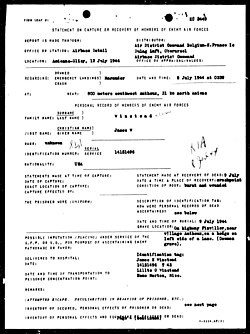
Missing Air Crew Reports (MACRs) are essential records for anyone researching military history, especially concerning the aircrew members of the United States Army Air Forces during World War II. These reports were created when aircraft and their crews were reported missing during missions. Here's a how to guide on researching MACRs effectively.
Research your ancestors on MyHeritage
What MACRs Contain
Before diving into research, it is important to understand what information MACRs typically include:
- Names of the Crew Members: Full names, ranks, crew positions, serial numbers, and names and address of next of kin.
- Aircraft Details: Type, serial number, and squadron.
- Mission Details: Date, time, location, and objectives of the mission as well as place of departure and flight plan destination.
- Circumstances of Loss: Information on where and how the aircraft was lost, weather conditions and visibility at time of loss, as well as cause of crash.
- Eyewitness Statements: Accounts from other crew members or individuals who witnessed the event.
Identify the Unit or Squadron
To find the correct MACR, you need to know the unit or squadron to which the missing aircrew belonged. This can usually be determined through:
- Service records: Start with the individual's military service records to determine their assigned unit.
- Historical Context: Research the broader mission or campaign during which the crew went missing.
Locate the MACR Number
Every MACR is assigned a unique number. This number can be found in various ways:
- Online Databases: Websites like the American Air Museum in Britain provide searchable databases where you can find the MACR number using the airman’s name or aircraft serial number.
- National Archives: NARA maintains an index of MACRs where you can look up the report by the date of the loss and unit. In addition, NARA offers a lookup service via e-mail to archives2reference@nara.gov. Provide as much information as possible relating to the missing air crew. The most important information to include is: 1) date of loss of the aircraft, 2) tail number of lost aircraft and/or 3) first and last name of the crew member
Accessing the MACR
Once you have the MACR number, you can access the report in a few different ways:
- National Archives and Records Administration (NARA): The National Archives holds digitized copies of the MACR name index and the many of the air crew reports, both of which are available on NARA's online Catalog. The name index is available in Record Group 92, Entry A1 2109-A, Series: Card Index to Missing Air Crew Reports. The air crew reports are available in Record Group 92, Entry A1 2109-B, Series: Missing Aircrew Reports (MACRs).
- Local or Regional Archives: Some MACRs may be available at local or regional archives, particularly if the aircraft was lost near that area.
Analyzing the MACR
Carefully read through the MACR to gather as much information as possible:
- Cross-reference: Compare the MACR details with other sources, such as eyewitness accounts, mission reports, or unit histories, to verify and expand upon the information.
- Eyewitness Statements: Pay close attention to these sections, as they often provide valuable insights into what happened to the aircraft and crew.
- Maps and Coordinates: If the MACR includes location data, use historical maps to understand the geographical context.
Expanding Your Research
MACRs are just one part of the puzzle. To gain a fuller picture, consider the following additional steps:
- Research Individual Crew Members: Look into the service records, medals, and personal histories of the crew. If your ancestor was one of the crew members, it is likely other crew members could be part of the ancestor's F.A.N. Club.
- Explore Related Records: Investigate mission reports, unit histories, and post-war reports (like POW or MIA files) for more context.
- Connect with Other Researchers: Join forums, online groups, or historical societies dedicated to WWII air history to share findings and learn from others.
Document Your Findings
As you gather information, ensure you document your findings systematically:
- Create a Research Log: Keep a detailed log of the sources you’ve consulted, including dates and specific details.
- Organize Documents: Store copies of MACRs, notes, and related documents in an organized manner for future reference.
By following these steps, you can effectively research Missing Air Crew Reports and uncover the stories of the brave men and women who served during World War II.
See also
Explore more about Missing Airforce Crew Reports ...
- Missing Air Crew Reports (MACRs) - National Archives and Records Administration
- Missing Air Crew Reports from WWII, MACRs - Air Force Historical Support Division (AF/HOH)
- Air Force Magazine 1926-2015 - Internet Archive
- American Air Museum in Britain


